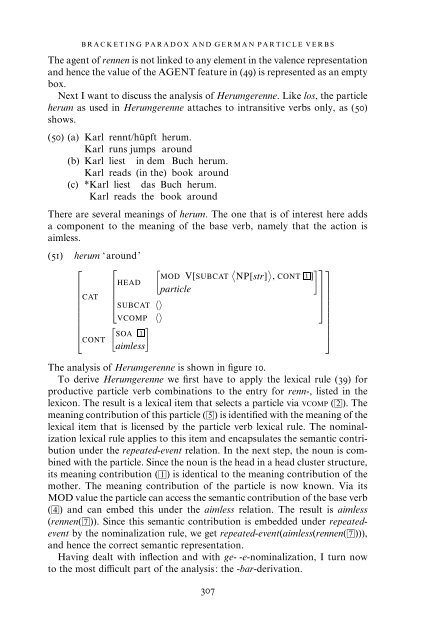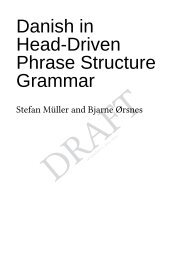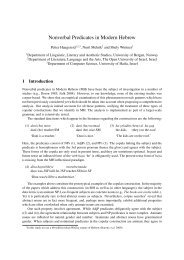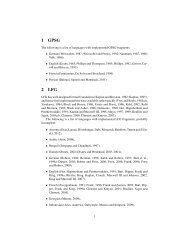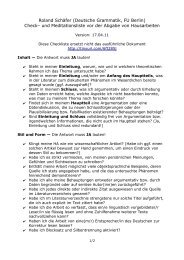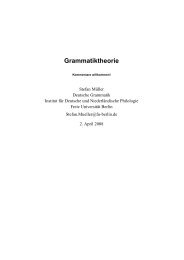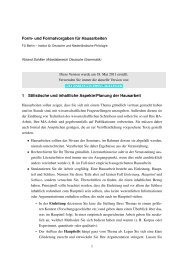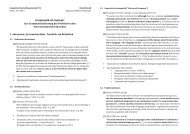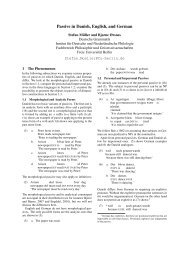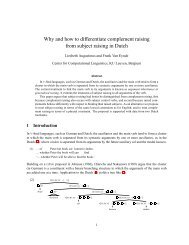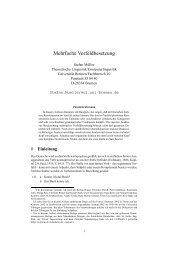Solving the bracketing paradox - German Grammar Group FU Berlin
Solving the bracketing paradox - German Grammar Group FU Berlin
Solving the bracketing paradox - German Grammar Group FU Berlin
Create successful ePaper yourself
Turn your PDF publications into a flip-book with our unique Google optimized e-Paper software.
BRACKETING PARADOX AND GERMAN PARTICLE VERBS<br />
The agent of rennen is not linked to any element in <strong>the</strong> valence representation<br />
and hence <strong>the</strong> value of <strong>the</strong> AGENT feature in (49) is represented as an empty<br />
box.<br />
Next I want to discuss <strong>the</strong> analysis of Herumgerenne. Like los, <strong>the</strong> particle<br />
herum as used in Herumgerenne attaches to intransitive verbs only, as (50)<br />
shows.<br />
(50) (a) Karl rennt/hüpft herum.<br />
Karl runs jumps around<br />
(b) Karl liest in dem Buch herum.<br />
Karl reads (in <strong>the</strong>) book around<br />
(c) *Karl liest das Buch herum.<br />
Karl reads <strong>the</strong> book around<br />
There are several meanings of herum. The one that is of interest here adds<br />
a component to <strong>the</strong> meaning of <strong>the</strong> base verb, namely that <strong>the</strong> action is<br />
aimless.<br />
(51) herum ‘around’<br />
⎡ ⎡ [ 〈 〉 ] ⎤⎤<br />
MOD V[SUBCAT NP[str] , CONT 1 ]<br />
HEAD<br />
particle<br />
CAT ⎢<br />
⎥<br />
⎣SUBCAT ⎢<br />
〈〉<br />
⎦<br />
⎥<br />
⎢<br />
⎣<br />
CONT<br />
VCOMP 〈〉<br />
[ ] SOA 1<br />
aimless<br />
The analysis of Herumgerenne is shown in figure 10.<br />
To derive Herumgerenne we first have to apply <strong>the</strong> lexical rule (39) for<br />
productive particle verb combinations to <strong>the</strong> entry for renn-, listed in <strong>the</strong><br />
lexicon. The result is a lexical item that selects a particle via VCOMP (2). The<br />
meaning contribution of this particle (5) is identified with <strong>the</strong> meaning of <strong>the</strong><br />
lexical item that is licensed by <strong>the</strong> particle verb lexical rule. The nominalization<br />
lexical rule applies to this item and encapsulates <strong>the</strong> semantic contribution<br />
under <strong>the</strong> repeated-event relation. In <strong>the</strong> next step, <strong>the</strong> noun is combined<br />
with <strong>the</strong> particle. Since <strong>the</strong> noun is <strong>the</strong> head in a head cluster structure,<br />
its meaning contribution (1) is identical to <strong>the</strong> meaning contribution of <strong>the</strong><br />
mo<strong>the</strong>r. The meaning contribution of <strong>the</strong> particle is now known. Via its<br />
MOD value <strong>the</strong> particle can access <strong>the</strong> semantic contribution of <strong>the</strong> base verb<br />
(4) and can embed this under <strong>the</strong> aimless relation. The result is aimless<br />
(rennen(7)). Since this semantic contribution is embedded under repeatedevent<br />
by <strong>the</strong> nominalization rule, we get repeated-event(aimless(rennen(7))),<br />
and hence <strong>the</strong> correct semantic representation.<br />
Having dealt with inflection and with ge- -e-nominalization, I turn now<br />
to <strong>the</strong> most difficult part of <strong>the</strong> analysis: <strong>the</strong> -bar-derivation.<br />
307<br />
⎥<br />
⎦


